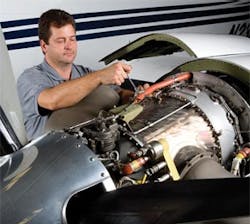Turbine engines are many aircraft technicians’ bread-and-butter. But even the most experienced technician can benefit from some sage advice on turbine repair and servicing, as provided by the experts at Dallas Airmotive and Standard Aero. Here is the cream of their collected wisdom, distilled into 10 Top Tips for Turbines!
1. Before you start, think
Tearing a turbine engine apart when you haven’t formulated a plan of attack first is a recipe for disaster. Not only could you miss the problem you are trying to fix, but you could even make matters worse, not better. This is why Standard Aero SVP of Technology Kim Olson stresses “getting your overall mindset together first. You need to go over the fault reports you’ve got, then pull out the manuals and look them over carefully,” he tells AMT. “Next, you have to use this information to put together a comprehensive plan of attack, making sure that you take the right tools for the job and follow the proper precautions as well. Do your homework before you start diving in and turning wrenches!”
2. Talk to the flight crew
Troubleshooting an intermittent fault is a technician’s worst nightmare, especially when it can’t be recreated in the shop. This is why it is important to thoroughly debrief the flight crew to find out the conditions under which the fault occurred. “Does it only occur at 18,000 feet or when the anti-icing system is on? These are details that can help you pinpoint a problem,” says Larry Galarza, Dallas Airmotive’s 731 field service manager. “But you can only learn about these details if you talk to the flight crew and get comprehensive answers first. So get out there and ask questions; lots
of questions.”
3. Let’s say it again – read the manual
When it comes to making mistakes in turbine repair, “the most common error is not to read the manual first,” says Olson. “I know we’re guys and that we like to assemble things before we ever look at a manual, but turbine engines are complicated. Read first, then act.”
4. Troubleshoot carefully
When you are troubleshooting a turbine, take your time and be careful not to jump to conclusions. “Every detail counts,” explains Olson. “Depending on the symptoms and evidence you find, troubleshooting will lead you to draw different conclusions. Rush through the process, and you could end up drawing the wrong conclusions; to the detriment of the engine and possibly yourself.”
5. Work methodically
Turbine engines are complex, so be sure to approach them in a logical manner. In particular, work in a methodical, step-by-step basis. You don’t want to find yourself at job’s end with a few unexplained spare parts!
6. Know your limitations
It is important to know what you are capable of doing on a turbine engine, and when you are out of your league. “Don’t be afraid to pick up the phone to ask someone for qualified advice,”says Terry Huecker, Dallas Airmotive’s Pratt & Whitney 300/500 field service manager. “Many companies such as Pratt & Whitney and Honeywell have excellent help desks. As well, it makes sense to build a community of technicians who you can consult and who can consult you. You can meet them at training courses, conventions, or even social events. Wherever you find them, get networking today to have people to call tomorrow.”
7. Get out your borescope
When in doubt, it makes sense to get a closer look at possible problem areas inside an engine using a borescope. “If you go in early enough, you can often catch a problem such as a cracked blade before it becomes serious,” says Olson. “Problems caught early are easier and less expensive to fix, and don’t result in additional problems such as having damaged blade fragment and damaging the entire engine.”
8. Take the turbine’s temperature
Tracking down an elusive problem? Try checking the turbine’s inlet temperature over time — using data downloaded from the aircraft’s monitoring system — “can guide you as to where you should start looking,” Olson says.
9. Don’t be rushed
When it comes to troubleshooting and then repairing a turbine engine, give yourself the time to do the job correctly. “A lot of times aircraft technicians get caught up in the hurry to get an aircraft back into service,” says Galarza. “Don’t let them put a flight schedule in front of you. Stick to your skills and your expertise, and do the job properly at the right pace.”
10. Finally, a clean turbine is a happy turbine
Well, maybe not happy, but taking the time to do compressor washes on a regular basis can reduce blade corrosion. In turn, reduced blade corrosion means longer life and more efficient fuel usage; a critical concern given today’s sky-high fuel prices.
“I have seen a number of engines that were stored for future repair without having their compressors washed,” Olson says. “The resulting corrosion can be so bad that the engine may end up being irreparable by the time it gets pulled out of storage for servicing.” He adds that fuel nozzle cleaning “is also very important for a turbine engine’s health and longevity.”
